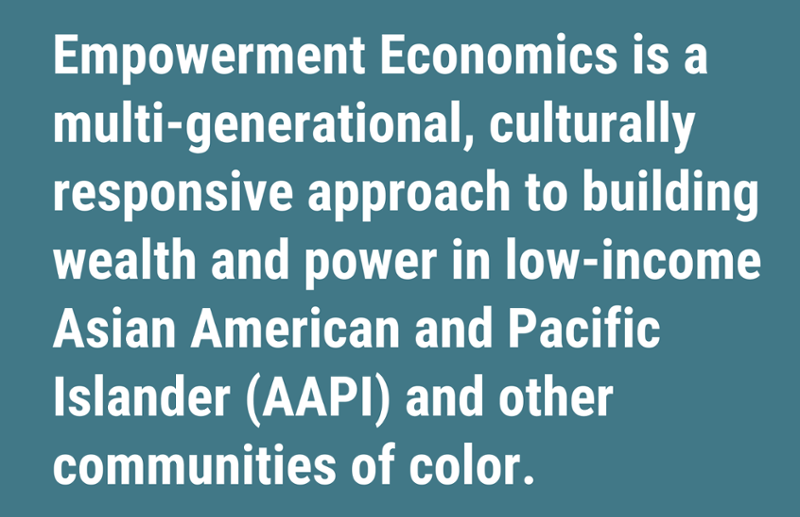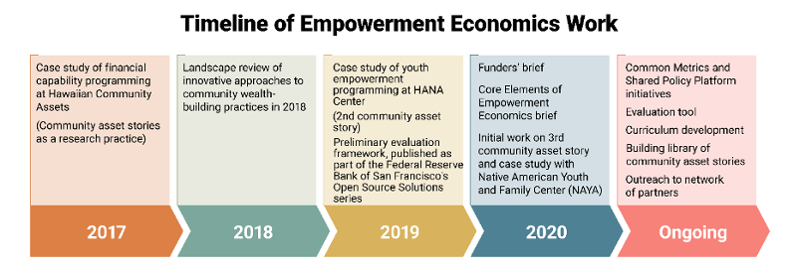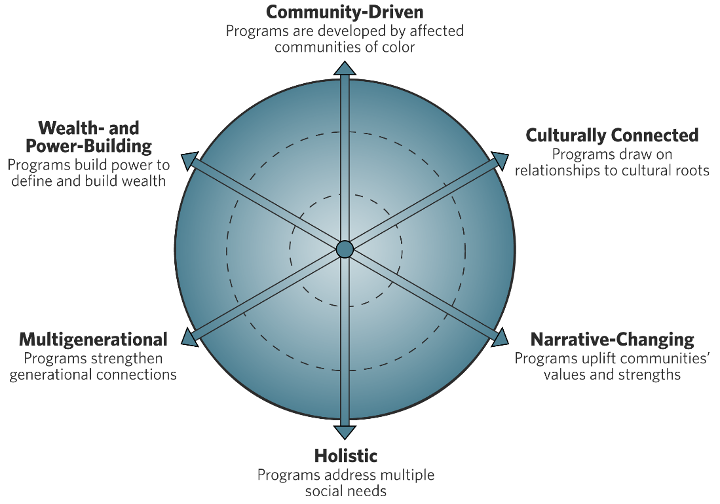 Dominant approaches to assets focus exclusively on individual behavior and center a very limited notion of assets as moneyed wealth. This framework ignores the historical and contemporary relationships of power that exist between marginalized communities and the economic system. These field-level blind spots perpetuate harmful narratives about individual and community capabilities, ignore local practices of resistance and resilience, and treat economic justice as separate from social justice. This traditional approach fails to appropriately recognize how race, gender, nation, and culture mediate individual and community participation in economic systems.
Dominant approaches to assets focus exclusively on individual behavior and center a very limited notion of assets as moneyed wealth. This framework ignores the historical and contemporary relationships of power that exist between marginalized communities and the economic system. These field-level blind spots perpetuate harmful narratives about individual and community capabilities, ignore local practices of resistance and resilience, and treat economic justice as separate from social justice. This traditional approach fails to appropriately recognize how race, gender, nation, and culture mediate individual and community participation in economic systems.
Empowerment Economics seeks to disrupt this western-centric foundation that has fueled decades of anti-poverty and economic empowerment agendas. In its place, Empowerment Economics provides a space to innovate, advance, and sustain work that centers the interconnected nature of racial and economic justice. This approach begins with situating each community’s past and current wellbeing within the context of economic, political, and racial systems, and critically examining those systems. A community’s strengths, cultures, values, and programs provide a path for deeper involvement, cooperation, and ownership by the local community.
- Empowerment Economics: Research, Practice, and Networks
- The Core Elements and Practice of Empowerment Economics
- Scholarly Contributions and Legacies
- Linking Research and Practice
- Current Work
Empowerment Economics: Research, Practice, and Network

Empowerment Economics emerged from the financial capability and advocacy works of a native Hawaiian community organization called Hawaiian Community Assets (HCA), and other Asian American and Pacific Islander (AAPI) community leaders. Empowerment Economics was built and relies upon a strong partnership between the Institute on Assets and Social Policy (IASP), National CAPACD, and HCA. This partnership between research, network-building, and practice began in 2016. The following year, the first case study, Foundations for the Future: Empowerment Economics in the Native Hawaiian Context, was published, catalyzing the term “Empowerment Economics.” Foundations for the Future offers key insights into HCA’s culturally relevant and multigenerational financial education programming. It also illustrates how Empowerment Economics differs from traditional mainstream financial capability models in providing a more holistic, community-led framework.
Following Foundations for the Future, the Root to Fruit case study examined how HANA Center, a Korean-led organization working in a multi-ethnic community of Chicago, practices Empowerment Economics. The case study focuses on HANA Center’s youth programs, emphasizing how these programs practice Empowerment Economics through financial capability programming and civic engagement.
Over the past four years, IASP has worked closely with National CAPACD and HCA to develop the framework and core elements of Empowerment Economics and expand this collaboration to other organizations and funders. Included in that work was a landscape review of AAPI organizations' financial capability work, an evaluation framework matrix, and a preliminary evaluation framework report.
The Core Elements and Practice of Empowerment Economics
The core elements of Empowerment Economics distinguish Empowerment Economics from traditional approaches to economic and community development. These core elements hold together the methods – both specific and diverse – of Empowerment Economics, developed in and across communities of color.
Empowerment Economics’ six core elements provide a guiding framework for organizations, funders, and advocates who seek to engage these principles in their programs and overall work. Additionally, the core elements offer space to reflect on how power and wealth are redistributed in more equitable ways and center the voices of communities of color.
 Inspired by HCA’s work, the six core elements of Empowerment Economics are:
Inspired by HCA’s work, the six core elements of Empowerment Economics are:
- Community-driven: Programs are developed by members of the affected community
- Culturally connected: Programs draw on relationship to cultural roots as sources of strength, vital knowledge, and new ways to shape community life
- Narrative-changing: Programs uplift the strengths, values, and capabilities of individuals, families, and communities
- Holistic: Programs address multiple social needs (e.g., housing, financial capability, leadership, workforce development, etc.)
- Multigenerational: Programs reach multiple generations, facilitate knowledge-sharing, and strengthen connections within and across generations
- Wealth- and power-building: Programs build power to define and build wealth
Scholarly Contributions and Legacies
Empowerment Economics is a partnership between community organizations, institutional funders, and academia. The research team at the Institute on Assets and Social Policy at the Heller School for Social Policy and Management takes on the primary responsibility of studying and synthesizing the practice of Empowerment Economics to forward interventions and make advancements in several related fields and disciplines. At its core, Empowerment Economics’ scholarly roots lie in multiple anti-racist, anti-poverty, and dialogic intellectual traditions both in and outside of the academy.
The Empowerment Economics scholarly framework was developed by placing disciplines like Native Hawaiian Studies, Asian American Studies, and community-specific iterations of Critical Race Theory in conversation with the broad literature on financial capability, development economics, social movements, and participatory action research. Each of these fields has much to offer on its own. However, putting them in conversation with each other and the community organizations practicing Empowerment Economics allows for unique opportunities to expand academic knowledge by making it both applicable and accountable to marginalized communities.
Linking Research and Practice
Through this scholarly framework, Empowerment Economics seeks to accomplish research that leads to action. The framework, case studies, reports, and core elements are geared toward action in communities from the ground up. This approach is essential to Empowerment Economics because we believe that grassroots action can lead to significant systemic change. Action research is informed by praxis, and our work begins with networks of communities practicing Empowerment Economics. These networks lead to research that informs the Empowerment Economics framework, which in turn provides a way for organizations to challenge the existing inequities of wealth and power. Empowerment Economics’ action research model is not just for practitioners but can help shift grantmaking practices in the philanthropic sector. Empowerment Economics can assist funders’ understanding of what to measure and fund, with the goal of reallocating and distributing wealth more equitably.
Current Empowerment Economics and Related Work
The Empowerment Economics’ network is continually expanding as we partner with place-based organizations to provide ground-up approaches to community wealth-building and power-shifting.
Current Empowerment Economics projects include:
- Third Case Study: Following the Foundations for the Future and the Root to Fruit case studies, a third case will examine Empowerment Economics from the lens of the core elements. We have partnered with the Native American Youth and Family Center (NAYA) in Portland, OR, to conduct this case study.
- Funders’ Brief: Empowerment Economics is not solely a framework for practitioners but can provide a new model to measure success from a funder’s perspective. Our team is working to understand how funders are reacting to and engaging with Empowerment Economics. This brief will demonstrate how Empowerment Economics can help shift the philanthropic field as a whole toward more equitable funding practices for community-based organizations.
- Empowerment Economics Evaluation Tool: IASP is partnering with Eric Wat and National CAPACD to develop a tool for program managers to evaluate Empowerment Economics in relation to their work. Building on the case studies and evaluation matrix, this evaluation tool will help collect data from program participants and assess anticipated outcomes.
- Curriculum Development: IASP is contributing to the development of a curriculum in partnership with HCA and National CAPACD. This curriculum aims to engage practitioners in technical assistance training and will be created and facilitated around the core elements of Empowerment Economics.
Empowerment Economics provides space for organizations and programs to engage with this work in their unique place-based contexts. Below are examples of research and collective work that are informed by Empowerment Economics:
- MassUP Winchendon Economic Empowerment Evaluation: IASP is partnering with the HEAL Winchendon Economic Empowerment coalition to provide thought partnership and evaluation services for a project seeking to address racial and economic inequities in Winchendon, MA. This 3.5-year project focuses on upstream factors impacting equity in Winchendon, including civic engagement, leadership, healthy food systems, and inclusive decision-making.
- Youth Participatory Action Research: IASP is partnering with Waltham Partnership for Youth (WPY), providing training for Waltham High School students and WPY staff on a Youth Participatory Action Research project. Through this project, students seek to collectively understand and act on social justice issues that affect their community.

